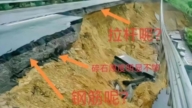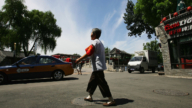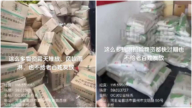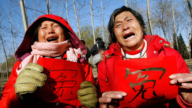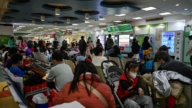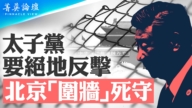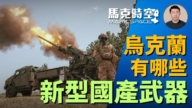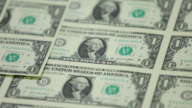【新唐人2011年10月1日讯】最近,中共党报《人民日报》刊登了《“中国税负世界第二”说法不实》一文,引发舆论讨论。有学者提出,税负是否“痛苦”不应只纠缠于税负高低,更应关注财政支出结构是否合理。那么,中国的财政收支结构是否合理?钱都花在了什么地方?不过,中共财政部给出的答案——公共财政支出2/3用于民生,更是让民众哗然。
《人民日报》9月30号刊登了记者李丽辉的文章,文章说,由于今年一个完整的财政年度还没有结束,所以用去年(2010年)的财政决算资料来分析。文章指出,2010年中国公共财政支出89874.16亿元,其中用于民生方面的支出占2/3。
9月13号,中共财政部公布今年前8个月的中国公共财政收入,累计有74286.29亿元,比去年同期增长30.9%。
《人民日报》的这个消息让民众一片哗然,表示不相信,说:《人民日报》真幽默,什么时间改登笑话了,应该是他们把我们的钱用掉了2/3才对!
网友也表示,自己编数字自己解释,好像在忽悠傻子。问题在于:很多钱都被种种大大小小的官员吃了,喝了,贪污了。
北京师范大学NBA导师段绍译:“我认为这个财政支出,很多该花的没花,不该花的都花了,中国政府用了很多财政的收入用于投资,这是不对的,政府不要与民争利啊。”
那么,《人民日报》这笔账究竟是怎样算出来的呢?我们来看看财政部有关负责人列出的,用于民生方面的“账单”。
例如:教育支出12550.02亿元,比2009年增长20.2%,占全国公共财政支出的14%。
不过,今年中共两会期间,《中国经济周刊》报导,根据中国教育部财务司、《中国统计年鉴2009》及国家统计局公布的资料计算,从2000年到2009年10年间,国家财政性教育经费支出10年累计“欠账”已达16843亿元。2002年到2003年间,经费投入甚至还出现了0.06%的倒退。
在医疗卫生支出方面,《人民日报》给出的数据是4804.18亿元,比2009年增长20.3%,占全国公共财政支出的5.3%,
中国的医改一直被广为诟病,改来改去,老百姓还是觉得看病难、看病贵。《南方都市报》今年4月份采访了中国卫生法学会会长、卫生部原副部长孙隆椿,他指出,中国新医改最大困难在于政府投入不够。中国的医疗总费用不足GDP的5%。中等发达国家的比率一般占到8%-9%。
此外,《人民日报》提出,社会保障和就业支出达到了9130.62亿元,比2009年增长20%。
截至2009年年底,中国超过10%的人口在60岁以上,已是名副其实的老龄化国家。而在中国的养老保险体系中,问题最大、涉及人口最多的是农村养老保险。
一位姓方的湖南农民在接受BBC中文网的电话采访时说,国家给农民的养老保险金太少了,最低每月55元,最高不会超过一百元。
对比美国,据大陆经济学家陈志武介绍,美国政府财政开支的73%用于社会保障、医疗卫生、教育文化等公共产品,行政开支只占10%;而中共政府开支只有25.5%用于这些事业。
新唐人记者陈汉、李静、周平采访报导。
2/3 Of Public Money Spent On People?
Recently Chinese Communist Party’ (CCP) newspaper,
People’s Daily, published an article,
titled ‘Chinese tax, the world’s second’
is a false statement". This led to a public discussion.
Scholars point out that the issue of whether the tax burden
is “painful" or not shouldn’t dwell on the level of tax only.
It is more important to pay attention on how reasonable are
the Chinese tax structure, financial revenue and expenditure.
And where do the money go. CCP’s Financial Ministry says
2/3 of public expenditure is spent on people’s livelihood.
This causes uproar amongst people.
On September 30, People’s Daily published an article
of the reporter Li Lihui, stating that last year’s financial data
were used for the analysis, as this financial year
is not over yet. The article points out,
that 2010 China’s public expenditure is RMB8987.4 billion,
2/3 of which was used for people’s livelihood.
On September 13, CCP’s Financial Ministry announced
that the first eight months of this year,
China’s public revenue totaled RMB7428.6 billion,
a 30.9% increase over the same period of last year.
This People’s Daily’ news caused uproar among people,
who doubt the figures, saying “People’s Daily is really funny.
Since when did it start to publish such jokes? They
maybe mean that 2/3 of our money are spent by them!”
Netizens also comment that this seems like cheating a fool
by explaining the figures that are made up by themselves.
The problem is a lot of money are wasted on dining, wining
and bribes by officials at all levels of the CCP government.
Duan Shaoyi (NBA mentor, Beijing Normal University):
“I think a lot of financial expenditure was used inadequately.
It’s wrong for the Chinese government to spend
a lot of the financial revenue on investments.
The government should not compete
with people’s interests.”
How did People’s Daily work out the calculation of the bill?
The person in charge of the Finance Ministry explains,
For example, education spending was RMB1255 billion,
20.2% up from 2009, 14% of the national public expenditure.
However, during the CCP’s two sessions this year,
China Economic Weekly reported that according to data,
of the Chinese Education Ministry’ Finance Division, “China
Statistical Yearbook 2009″ and National Bureau of Statistics,
during the 10 years from 2000 to 2009, the total budget
spending of state education has a “debt” of RMB1684.3 billion.
During 2002 and 2003, the funding even appeared
to have dropped by 0.06%.
In health care spending, the figure given by People’s Daily
is RMB480.4 billion, with 20.3% up from 2009,
accounting to 5.3% of the national public expenditure.
China’s ever changing medical reform is widely criticized.
People say that medical treatment is difficult and expensive.
Nanfang Dushi Bao interviewed in April Sun Longchun, chair
of Health Law Association and ex-vice Health minister.
Sun pointed out that the greatest difficulty of China’ medical
reform lies in the shortage of governmental investment.
China’s total cost of health care is less than 5% of GDP.
This figure is 8-9% for medium developed countries.
People’s Daily wrote also, social security and employment
spending reached RMB913 billion, with 20% up from 2009.
At the end of 2009, over 10% of China’s population
was over 60 years of age. It’s truly an aging country.
In the system of pension insurance in China, the biggest
problem with such a large population is the rural pensions.
A farmer, surnamed Fang from Hunan, told BBC Chinese
in a phone interview that the farmers’ pension payments
from the state are far too low,
ranging between RMB55 and RMB100 per month.
In contrast to America, where according
to Chen Zhiwu, economist in China,
73% of government’s expenditure is used for social security,
health care, education, culture and other public sectors.
Administrative costs are only 10%. In China, for those
sectors are allocated 25.5% of all government’ expenditure.
NTD reporters Chen Han, Li Jing and Zhou Ping




